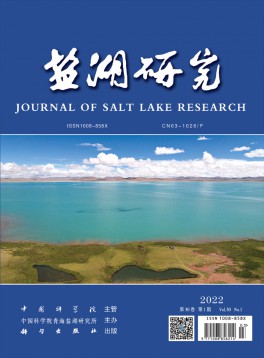Isothermal Evaporating Phase Equilibria in the Quaternary System (LiCl+NaCl+Li2SO4+Na2SO4+H2O)at 348.15 K and 0.1 MPa:An Experimental and Theoretical Study
關鍵詞:phase diagram solubility lithium chloride
摘要:The gradient solar pond technique is an economic separating process employed in the inorganic chemical industrial production of salt lake chemical engineering processes. In this paper, a novel isothermal evaporation experimental method was employed to simulate the evaporation phase equilibrium for the reciprocal quaternary system (LiCl+NaCl+Li2SO4+Na2SO 4+H2O) at 348.15 K to serve as a useful guide for lithium salt production via the depth solar ponds.The isothermal evaporation equilibrium solubilities and physicochemical properties,including the densities and pH values, were experimentally investigated. The dry-salt phase diagram,water-phase diagram, and the diagram of the physicochemical properties versus composition were plotted with respect to the experimental data. The dry-salt phase diagram consists of three invariant points,seven univariant solubility curves, and five crystallization regions, specifically halite(NaCl,Ha),thenardite (Na2SO4,Th),double salt (Li2SO4 · Na2SO4 , Db2), lithium sulfate monohydrate (Li2SO4 ·H2O, Ls), and lithium chloride monohydrate(LiCl·H2O, Lc). Based on Pitzer and its extended HMW model, the Pitzer single salt parameters, mixing ion interaction parameters, and thermodynamic stable equilibrium constants for the quaternary system at 348.15 K were obtained. The calculated phase diagram and experimental isothermal phase diagram at 348.15 K exhibited a great difference. Based on these results, the isothermal evaporation phase diagram can truly reflect the salt sedimentary in salt lakes and can be applied as a useful guide for the solar pond process.
鹽湖研究雜志要求:
{1}來稿請注明通訊地址、單位、郵編、電話等,本刊一律不退稿,請自留底稿。
{2}文稿應具有先進性、科學性、邏輯性和實用性。要求資料完整、可靠,觀點明確,文字精煉,層次清楚,數據準確并經過統計學處理。
{3}題名。題名一般不宜超過20個漢字,應緊扣文章主題,用語用詞嚴謹規范且利于網絡檢索。不得使用非公知公用、同行不熟悉的外來語、縮寫詞、符號和代號。
{4}參考文獻:參考文獻采用順序編碼制,參考文獻的序號以方括號加注于被注文字的右上角,內容按序號順序排列于文后,序號用方括號標注,按正文中出現的次序標引,文后沒有與文中引用相對應的參考文獻一律刪除。
{5}來稿請附中英文摘要(中文200—300 字左右)和關鍵詞(3—5 個)。
注:因版權方要求,不能公開全文,如需全文,請咨詢雜志社

